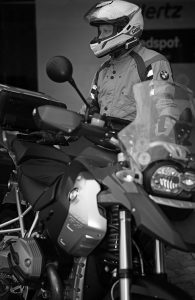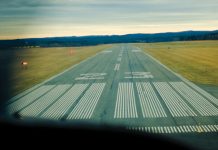Motorcycling may seem an unlikely source of safety-culture wisdom but there are lessons to be found there. They include paying attention to detail, exercising self-discipline and seeking always to do things better.
Riding a motorbike and flying an aircraft are united by a love of freedom—the freedom of the road on a bike; the freedom of the sky in the cockpit. It’s more than a coincidence, perhaps, that a significant number of private pilots are also motorcyclists. Both pursuits are a heady blend of lifestyle, values statement, and to a lesser extent, transport. Aficionados of the bike and the aircraft ride and fly chiefly for fun. Notwithstanding that, under certain circumstances, a traffic-congested city or a remote outback station, motorcycles and general aviation aircraft can be very useful indeed as a form of transport.
There’s another, grimmer, similarity. ‘Put crudely, private pilots are dying at the same rate as motorcyclists. And they are doing it in sadly predictable ways,’ former Chief Commissioner of the Australian Transport Safety Bureau, Martin Dolan, told the Safeskies conference.
In 2011, Dolan told Flight Safety Australia there were distinct philosophical similarities between private flying and motorcycling.
‘I think both are about an ethos of freedom and mobility, and both embrace a certain level of risk,’ Dolan says.
 ‘There certainly can be a higher level of risk acceptance in motorcycling, compared to car driving, but also a greater commitment to risk mitigation,’ says University of NSW Associate Professor Teresa Senserrick, who helped develop the education material for Victoria’s motorcycle licensing scheme.
‘There certainly can be a higher level of risk acceptance in motorcycling, compared to car driving, but also a greater commitment to risk mitigation,’ says University of NSW Associate Professor Teresa Senserrick, who helped develop the education material for Victoria’s motorcycle licensing scheme.
‘While there are a minority of conscious risk takers that is not the majority of motorcyclists. Many are in it because they love the sensation, the culture, the comradeship—it’s not quite the same thing.’
‘Because we’re more vulnerable on a bike than in a car there’s a groundswell of safety culture. It’s in the concepts of space, surface and sight, being aware of your road positioning, the road surface and how far and how well you can see to perceive hazards at any moment.’
Australia’s Chief of Defence, Air Chief Marshal Mark Binskin is an enthusiastic and experienced motorcyclist who sees distinct common themes in his experience of motorcycles, fast military jets and general aviation. ‘In an aircraft, you always leave yourself a margin for error, whether that be altitude, airspeed or fuel reserve,’ he says. ‘If you don’t give yourself similar margins in motorcycling you run into problems. Give yourself a few km/h less going into a turn because you can’t see the exit. Never plan to use the whole road in a corner because there might be some gravel, a pothole, something you can’t see. You need to give yourself the margin, and it’s exactly the same in an aeroplane.’

Binskin greatly enjoys his motorcycling, partly because on the bike he is ‘just Mark Binskin’, without rank or privilege. But he is clear eyed about the other parallel between motorcycles and aviation. ‘They’re both very unforgiving if you get it wrong—terribly unforgiving.’
‘On a motorcycle, if you don’t understand where you sit in the food chain on the road you’re going to get yourself in trouble.’
Motorcycling in Australia is becoming less dangerous, although motorcyclists remain much more likely to be killed or injured per kilometre than car drivers, bicycle riders or pedestrians.
Motorcycling has boomed in the 21st century. There are now about one million motorcycles and scooters on Australian roads, up from 420,000 in 2005. They make up 4.5 per cent of the 18 million vehicles on Australian roads. Registrations jumped by 22.3 per cent between 2010 and 2015 compared to 12.1 per cent growth in total vehicle registrations over the same period, Australian Bureau of Statistics data shows.
However, annual motorcycle deaths have fallen since 1995, and since 2011 have fluctuated around 200 a year. The death rate per 10,000 registered motorcycles has fallen from 8.7 in 1991, to 2.5 in 2015.
Like private pilots, motorcyclists are getting older—and living longer.
Figures for NSW show motorcycle riders aged 50 years and older account for 16 per cent of all motorcycle rider casualties and represent 42 per cent of rider licences on issue. Riders aged under 30 represent 11 per cent of licence holders, but account for 40 per cent of rider casualties, while riders aged between 30–49 years represent 47 per cent of rider licences on issue and account for 41 per cent of rider casualties.
Former Chairman of the Motorcycle Council of NSW, Christopher Burns, says, ‘The word is, older riders are over represented in crash statistics, but when you consider the number of bikes they own, they’re not over represented.’
In comments that many pilots would find familiar, Burns says the appeal of motorcycling is in its requirement for total concentration and performance to a high level. ‘For me, it’s being on the ball, being sharp, being mindful. When you ride, your mind is completely devoid of anything else. You don’t think about work; your mind is completely focused on what’s ahead.’
This highly developed situational awareness is essential for safe riding, Burns says. ‘Coming up to an intersection you’re looking at the cross-traffic, scanning the road for oil, flattened tin cans, sand, you’re scanning the rear-view mirrors to make sure you won’t be hit if you get on the brakes, and you’re looking for an escape route. That’s all for just going through an intersection. You might go through 50 of those on the way to work and you can’t take any of them for granted.’
Binskin describes the same process using aviation terms. ‘It’s 360 degree situational awareness. You’ve got to have your head on a swivel, looking for where the risk may emerge from. The aim is to get good at assessing the risks and to mitigate them. On a motorcycle you buffer, in an aircraft you manoeuvre to check your blind spots.’
Training and licensing
A motorcycle licence, like a pilot’s licence, requires commitment to acquire. Most Australian states have introduced graduated licensing for motorcyclists, requiring a mix of theory, off-road instruction, practice and testing. In Victoria, for example, a new rider has to attend and pass a two-day course before being given a learner permit. The course includes off-road training and an on-road assessment. The learner motorcyclist must also complete an on-road practical skills check (also known as a check ride) before they can book a motorcycle licence assessment.
NSW has eight steps between applying for a learner’s permit and being granted a full licence:
- Pre-learner training: seven hours over two sessions
- Rider knowledge test
- Learner rider licence (hold for a minimum three months and valid for 12 months)
- Pre-provisional training: six-hour course
- Motorcycle riding test
- Provisional (P1) rider licence (hold for a minimum 12 months and valid for 18 months)
- Provisional (P2) rider licence (hold for a minimum of 24 months and valid for 30 months)
- Full licence.
Tasmania is the latest state to adopt graduated licensing, with its scheme due to begin in May 2017.
Little information exists on the specific effect of motorcycle-graduated licensing, but a Queensland report into graduated licences for car drivers found implementation of a graduated-licensing system was associated with a statistically significant 31 per cent reduction in fatal crashes involving novice drivers.
Burns says rider training needs to continue after the licence is issued. ‘Most riders don’t believe they need more training than they already have. It’s unconscious incompetence. They don’t know what they don’t know. We call it upskilling. We’re encouraging partners of riders to buy their partner an advanced riding course. These are about advanced road skills, not limit of traction cornering.’

Technology
Motorcycles are belatedly joining the electronics revolution that has quietly taken place over the past 20 years in cars and trucks, and to some extent in light aircraft. Anti-lock braking, traction control and integrated stability control systems for motorcycles are all either currently available, or under development. Honda unveiled a self-balancing motorcycle at the International Consumer Electronics Show in Las Vegas in January 2017.
‘The technology on some motorcycles now includes anti-lock ABS braking, stability control, throttle control—on high performance motorcycles now you can select the performance level you want—and suspension adjustment,’ says Binskin, who enjoys several of these innovations on his BMW R1200 GS.
A German study found ABS could have avoided or reduced the severity of the impact in 93 per cent of motorcycle crashes. ABS brakes are now mandatory on motorcycles sold in the European Union, and making the technology mandatory on new bikes is under consideration in Australia.
However, Burns says, ‘We’re of the opinion that mandating ABS will not be a silver bullet. Mandating it means you will get cheap ABS on cheap bikes.’
Not all ABS systems are equal, Burns says. ‘Top-of-the-line ABS has bank angle sensing and other inputs, which are critical. When you’re cranked over at a 50 degree angle and you lose traction on the front wheel, before your ABS kicks in you’re going to wash out the front wheel. A bank angle sensor will change the parameters of the ABS on the front end.’
Effective rider training could have a similar effect, Burns says. ‘The main issue we’ve got is riders not using the front brake correctly. They just rely on the back.’
Beyond ABS is autonomous emergency braking, already offered on some cars. It detects imminent collisions and applies the vehicle’s brakes without action from the driver. A Monash University study found autonomous emergency braking systems for motorcycles could cut average collision speeds by five per cent, and significantly reduce pre-collision falls.
The rider remains the main safety component, however.
‘Technology is making bikes a lot safer, but you still have to ride them, as in aviation, where the pilot is the key part,’ Binskin says.

Details
An important element in aviation’s evolution from daredevil pursuit to an extraordinarily safe form of transport was attention to detail. Accidents were analysed in terms of human, machine and system performance, and the results used to make flying safer. Motorcycling is starting down this route, its advocates say.
Multi-vehicle crashes form 60 per cent of motorcycle crashes, Burns says. Of the remaining 40 per cent of single vehicle motorcycle crashes, half occur on straight roads.
‘We’re not convinced on the data on single vehicle crashes. They’re put down to poor rider training and behaviour, like the pilot error label you have,’ he says. ‘But there are a lot of factors not being taken into account.’
Burns describes the motorcycle condition of the ‘tank slapper’, a positive feedback flutter state in the steering, broadly analogous to aerodynamic flutter. ‘If you hit a succession of bumps at the wrong frequency, the front end goes, just like that.’
Animal strikes are similarly underrated as accident factors, he contends, quoting a study in western Queensland that attributed 25 per cent of single vehicle fatalities to animal strikes. ‘I hit a wombat once and took the footpeg off the bike. I stayed up, but had I died there would have been virtually no evidence. The cause would have been recorded as rider error.’
Fatigue is a more significant factor behind motorcycle handlebars than it is in an air-conditioned cabin, or perhaps, on a flight deck. A NSW government study identified fatigue as a contributing factor to around seven per cent of motorcycle crashes.
Burns says there is not enough root cause analysis in road accidents of any type, let alone two-wheel crashes, and wonders what safety lessons are continually being ignored as overworked police officers file cursory reports and wreckage is swept off busy roadways.
Knowing how the small details mesh is important in preventing accidents, he says. ‘Take suspension setup, where there’s a lamentable lack of knowledge. We had one instance where a woman said she couldn’t go round a corner. The trip leader said, “rubbish”. They swapped bikes, and the suspension was indeed so hard that when you hit bumps you literally couldn’t turn the bike into a corner.’
Government relations
The Motorcycle Council of NSW works closely with the state government’s Centre for Road Safety. ‘That gives us direct access to the decision-makers in developing strategy,’ Burns says. ‘Out of that have come things like the motorcycle safety working group and a 20-point safety implementation plan. We’re recognised as the subject matter experts in motorcycling. If there’s an urgent issue we now have the ability to make a call and get it sorted out.’
Burns emphasises that this state of affairs required planning, effort and discipline. ‘You need to win people’s trust that what you’re saying is correct. So you put forward an evidence-based position, show what the issue is, what the impacts are, and the solutions,’ he says. ‘When you do that, often enough they will get to trust your opinion. The other thing is don’t be too pushy. In years gone by, a lot of motorcycle advocacy was foot stamping and shouting. If you put forward an evidence-based argument, you can put your point across quietly.’
Risk management
‘Our message is that riders need to be good risk managers,’ says Burns. ‘If you want to go ten-tenths, ride on the track. Only ride as fast as you can see.’
Binskin says he abides by the same general rule for aircraft and motorcycles. ‘If the weather’s bad and you don’t have to do the journey, then don’t.’
The hazards of bad weather for motorcyclists include reduced vision, reduced visibility to other traffic, reduced cornering and braking traction and, increased fatigue.
Binskin sees risk management rather than risk taking as intrinsic to the delight of both motorcycling and flying. ‘To ride a motorcycle well requires a good level of hand-eye coordination, but also thought processes,’ he says.
‘The aim is to be a part of the bike. When your turning and your braking all start to come naturally, then you’ve got time for situational awareness. If you are focusing on hard braking and turning in late, you need to slow down, because you’re out of your rhythm and comfort zone and you’ve gotten behind the bike. It’s exactly the same in an aeroplane.
‘At the end of the day, after a good ride or a good flight it’s extremely satisfying. A feeling that you have performed to your best.’
Further information
Adoption of Anti-lock Braking Systems (ABS) for motorcycles in Australia Monash University Accident Research Centre on the effectiveness of motorcycle anti-lock braking systems. Report No.327 December 2015.






Comments are closed.